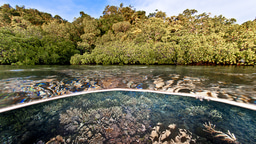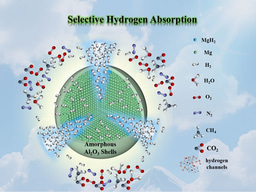A very low mutation rate spells trouble for shark populations.
Published in Genetics & Genomics

Low mutation rate in epaulette sharks is consistent with a slow rate of evolution in sharks. Nature Communications 19th October 2023.
https://www.nature.com/articles/s41467-023-42238-x
The paper in a nut shell: This study discovers that sharks possess the lowest level of mutation between generation of any vertebrate species to date. The results indicate that sharks evolve very slowly and and suggest that they may have less capacity to survive population bottle necks than other species. It reveals the urgent need to prioritise preservation of the remaining genetic diversity of global shark populations. It also provides an answer to the question as to why sharks may have low rates of cancer.
Why is it important to understand the rate of mutation in different animals? Mutations are the fundamental substrates of evolution because they generate variability within populations, enabling evolutionary change. The mutation rate (μ) is a crucial parameter for many calculations and predictive modelling in the fields of ecology and evolution, genetics, and genomics. The rate of mutation provides an indication of a species ability to generate diversity, with a low rate of intergenerational mutations indicative of a reduced ability to respond to population bottle necks.
Why study Sharks? Despite its importance, experimental determination of mutation rates in vertebrates has been strongly mammal-focused including a recent study reporting mutation rates in 68 vertebrate species. Sharks have not featured in any analysis of mutation rate so far. Sharks play important functional roles in the regulation and maintenance of a diverse range of marine ecosystems. However, little is known about the evolutionary rate and adaptive potential of shark populations, a fact that has come into sharper focus with the emergence of the dual ecological pressures of overfishing and habitat loss. Exacerbating the intense fishing pressures currently facing shark populations is the extreme nature of the life history characteristics that are exhibited by most shark species. Extant sharks are slow growing, reach sexual maturity late, and have few offspring. They exhibit some of the longest gestation periods and some of the highest levels of maternal investment in the animal kingdom. This generally results in slow population growth and delayed recovery after population collapse. They are therefore particularly sensitive to unsustainable fishing practices and rapid changes in habitats. How rapidly shark populations are able to evolve to counteract the mounting ecological threats that face them and rebound from historically low population densities will ultimately be dependent on the genetic diversity within populations, a value that itself is dependent on the germline mutation rate. Thus, to understand better how global shark population may respond to these mounting ecological pressures a determination of the intergenerational mutation rate is critical.
What did we do and what did we discover. We established the first “laboratory” shark model, the epaulette shark, Hemiscyllium ocellatum a small, benthic, oviparous species that inhabits coral reef environments in the waters north-east of Australia. Our development of captive breeding and pair mating protocols for the epaulette shark allows development of this species as a general model system for shark research and allows us to genetically evaluate the mutation rate within a shark pedigree. It facilitated the generation of full genome sequences of an entire pedigree of sharks to be performed, data that was used to generate the first direct estimate of the nuclear mutation rate in a shark species. The experimental design included generation of a high-quality annotated reference “trio” genome (the first for this part of the phylogeny), and whole genome resequencing of parents and nine offspring to detect de novo mutations. This study estimated a mutation rate of 7x10-10 per base pair, per generation, which represents the lowest directly estimated mutation rate for any vertebrate clade.
Why is this important. The study revealed that sharks are a slowly evolving lineage whose ability to restore genetic diversity following a sustained population bottleneck is likely to be hampered by this extremely low mutation rate. Consequently, this work provides compelling evidence for the need to prioritise preservation of the remaining genetic diversity of global shark populations. This is important to know as shark diversity is under severe pressure from over fishing and habitat loss.
Specifically shark populations are severely adversely affected by their incidental capture in fisheries directed at other species, with sharks caught as bycatch in the high seas pelagic longline fisheries being particularly impactful. Furthermore, many species are directly targeted by the ‘fin trade’, where shark fins are harvested for human consumption. This removes between 26 and 73 million sharks each year, with more than half of the species being under threat of extinction.
Finally, for many years specific shark populations have. also been harvested by an additional, particularly pernicious, industry which produces shark cartilage extracts as dietary supplements for cancer prevention or treatment. The use of this product is based on the claim that sharks do not get cancer. As the shark skeleton is made of cartilage, the hypothesis was put forward that the high amount of cartilage in the shark body prevents the development of cancer. However, the shark cartilage supplement industry persists despite the clinical efficacy of shark cartilage-based treatments of cancer being directly refuted by clinical trials. Furthermore, the existence of numerous studies documenting that different types of cancer do in fact occur in sharks has also failed to halt the use of shark cartilage supplements. Our results offer a logical explanation for the potential lower rate of cancer observed in sharks. Most cancers originate from spontaneous or induced somatic mutations. Studies have shown that the somatic mutation rate is approximately one order of magnitude higher than the germline mutation rate. Both values correlate with a lower germline mutation rate being accompanied by a lower somatic rate. Thus, we can also expect the somatic mutation rate in sharks to be low. Our results thus infer we infer that the low spontaneous mutation rate of sharks could contribute to the low incidence of tumours suggested for sharks, which has nothing at all to do with the property of cartilage harvested from sharks.
Importantly our results also indicate that similar low mutation rates in other shark species may result in long-term negative effects of population bottlenecks in already endangered and overfished species. Our study, therefore, provides compelling evidence for the need to prioritise preservation of the remaining genetic diversity of global shark populations, many of which face extraordinary challenges in over-coming an ever-increasing ratchet of ecological pressures.
Peter Currie. peter.currie@monash.edu
Frank Tulenko. frank.tulenko@monash.edu
Ashley T. Sendell-Price ashley.sendell-price@imbim.uu.se
Follow the Topic
-
Nature Communications

An open access, multidisciplinary journal dedicated to publishing high-quality research in all areas of the biological, health, physical, chemical and Earth sciences.
Related Collections
With Collections, you can get published faster and increase your visibility.
Clinical trials 2025
Publishing Model: Open Access
Deadline: Dec 31, 2025
Women's Health
Publishing Model: Hybrid
Deadline: Ongoing






Please sign in or register for FREE
If you are a registered user on Research Communities by Springer Nature, please sign in